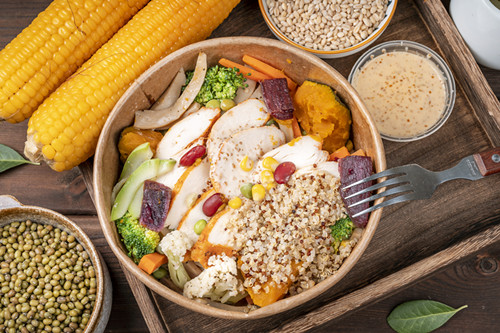On February 10, 2025, National Health Commission of the People’s Republic of China (NHC) issued an announcement (No. 1 of 2025) for “Three New Foods” with 20 products approved:
- five new food raw materials;
- eight new food additives; and
- seven food-related products.

Details are as follows:
New food raw materials
Stevia polyphenols
Name | Stevia polyphenols |
Basic information | Source: leaves of stevia polyphenols |
Brief introduction of the production process | Made from the leaves of stevia polyphenols through processes such as ethanol extraction, filtration, purification, concentration, and drying. |
Recommended intake | ≤500 mg/day |
Other information | 1. Scope of use and maximum use level: - Milk and dairy products: modified milk and flavored fermented milk 0.5 g/kg; modified milk powder is calculated based on the reconstituted liquid mass; cheese, processed cheese, cheese products, and condensed milk are calculated based on the multiple of raw milk. - Beverages: liquid beverages ≤50 mL packaging: 5 g/kg; 51-500 mL packaging: 0.5 g/kg; solid beverages are calculated based on the reconstituted liquid mass. - Jelly: 8 g/kg. - Cocoa products, chocolate, and chocolate products (including cocoa butter substitutes and products): 8 g/kg. - Candies: 25 g/kg. - Frozen desserts: 5 g/kg. - Alcoholic beverages: 2.5 g/kg. - Preserved fruits: 5 g/kg. 2. Not suitable for infants, pregnant women, and breastfeeding women. Labels and instructions must indicate unsuitable populations and consumption limits. 3. Quality specifications and food safety indicators are listed in the appendix. |
Lemon myrtle leaf
Name | Lemon myrtle leaf | |
Basic information | Source: leaves of Backhousia citriodora F. Muell. | |
Brief introduction of the production process | Made from the leaves of Backhousia citriodora F. Muell. through processes such as picking, sorting, cleaning, and drying. | |
Other information | 1. Not suitable for infants, pregnant women, and breastfeeding women. Labels and instructions must indicate unsuitable populations and consumption limits. 2. Food safety indicators are listed as follows. | |
Pb, mg/kg | ≤1.0 | |
Cd, mg/kg | ≤0.5 | |
As, mg/kg | ≤0.5 | |
Maqui berry anthocyanins
Name | Maqui berry anthocyanins |
Basic information | Source: fruits of aristoteliachilensis |
Brief introduction of the production process | Made from the fruits of aristoteliachilensis through processes such as extraction, filtration, purification, concentration, and drying. |
Recommended intake | ≤900 mg/day |
Other information | 1. Scope of use and maximum use level: - Milk and dairy products: modified milk and flavored fermented milk 0.8 g/kg; modified milk powder is calculated based on the reconstituted liquid mass. - Beverages: liquid beverages ≤50 mL packaging: 8 g/kg; 51-500 mL packaging: 0.8 g/kg; solid beverages are calculated based on the reconstituted liquid mass. - Jelly: 14 g/kg. - Cocoa products, chocolate, and chocolate products (including cocoa butter substitutes and products): 14 g/kg. - Candies: 40 g/kg. - Frozen desserts: 8 g/kg. - Baked food: 4 g/kg. - Alcoholic beverages: 4 g/kg. 2. Not suitable for infants, pregnant women, and breastfeeding women. Labels and instructions must indicate unsuitable populations and consumption limits. 3. Quality specifications and food safety indicators are listed in the appendix. |
Wheat polar lipids
Name | Wheat polar lipids |
Brief introduction of the production process | Made from wheat flour through processes such as ethanol extraction, acetone precipitation, separation, drying, and grinding. |
Recommended intake | ≤30 mg/day (calculated based on a digalactosyldiacylglycerol content of 40g/100g. If the content exceeds this amount, it will be converted according to the actual content.) |
Other information | 1. Scope of use and maximum use level: - Beverages: liquid beverages ≤50 mL packaging: 0.6 g/kg; 51-500 mL packaging: 0.06 g/kg; solid beverages are calculated based on the reconstituted liquid mass. 2. Not suitable for infants, pregnant women, and breastfeeding women. Labels and instructions must indicate unsuitable populations and consumption limits. 3. Quality specifications and food safety indicators are listed in the appendix. |
Calcium β-hydroxy-β-methyl butyrate (CaHMB)
Name | Maqui berry anthocyanins | |
Basic information | Structure: Molecular formula: C10H18O6Ca?H2O Molar mass: 292 | |
Brief introduction of the production process | Made from sodium hypochlorite, diacetone alcohol, hydrochloric acid, ethyl acetate, ethanol, and calcium hydroxide as the main raw materials, through processes such as oxidation synthesis, acidification, extraction, neutralization reaction, centrifugation, and drying. | |
Recommended intake | ≤6 mg/day | |
Specifications | Properties | White powder |
Β-hydroxy-hydrazine-methylbutyric acid, g/100g | 77-82(test method in Appendix A) | |
Ca, g/100g | 12-16 | |
Water, g/100g | 5.0-7.5 | |
2-Hydroxy-3-methyl-2-butenoic acid, % | ≤8.0 (test method in Appendix B) | |
alpha,beta-dihydroxyisovaleric acid, % | ≤4.5 (test method in Appendix B) | |
Other information | 1. Scope of use: beverages, milk and dairy products, cocoa products, chocolate and chocolate products, candies, baked food, sports nutrition products, and FSMPs. 2. Not suitable for infants, pregnant women, and breastfeeding women. Labels and instructions must indicate unsuitable populations and consumption limits. 3. Quality specifications and food safety indicators are listed as follows. | |
Pb, mg/kg | ≤1.0 | |
As, mg/kg | ≤1.0 | |
Chloroform, mg/kg | ≤1.0 | |
Total colony count | ≤1000 | |
Coliform bacteria | ≤10 | |
New food additives (eight types)
New food additives
Butylated hydroxytoluene
Functional classification: antioxidants
Scope of use and usage level: The scope of use and usage level shall comply with the National Food Safety Standard for Food Additives-Butylated Hydroxytoluene (GB 2760).
Specifications: The specifications apply to food additive butylated hydroxytoluene, which is made from a reaction of para-cresol and isobutene using catalysts such as concentrated sulfuric acid, sodium p-toluenesulfonate, and sodium benzenesulfonate, followed by distillation and recrystallization. The remaining content shall comply with the National Food Safety Standard for Food Additives – Butylated Hydroxytoluene (GB 1900).
Note a: The mixture of para-cresol and ortho-cresol obtained by the reaction of phenol and methanol.
New food enzymes
No. | Enzyme | Source | Donor |
1 | Phosphodiesterase I | Leptographium procerum | - |
2 | Lipase | Komagataella phafi | Streptomycessp. |
The quality specifications for enzymes used in the food industry shall comply with the provisions outlined in the National Food Safety Standard for Food Additives – Enzymes for Food Industry (GB 1886.174).
New Food Spices
Hydroxycitronellal
Functional classification: food spices
Application scope and usage level:
Category number | Food name | Usage level | Note |
- | Prepared as food spice (except for the food categories listed in Table B1 of GB 2760) | Use in appropriate amounts as required by production | - |
Quality specifications:
Applicable to food additive hydroxycitronellal produced from citronellol as a raw material through a chemical reaction. The remaining content shall comply with the provisions of the National Food Safety Standard for Food Additives – Hydroxycitronellal (GB 1886.117).
New food nutrition enhancers
2’-fucosyllactose, 2’-FL
Functional classification: food nutrition enhancers
Application scope, usage level, and specifications: The application scope and specification for 2'-Fucosyllactose shall follow the Notice No. 8 of 2023 issued by the National Health Commission (except for the information on the production strains used for 2'-Fucosyllactose production in Appendix C). The information on the production strains for this new nutrition enhancer is provided in the table below.
Nutrition enhancer | Source | Donor |
2’-fucosyllactose | E. coli BL21 (DE3) | Helicobacter spp.a |
E. coli W | Helicobacter spp.a |
ais the donor of α-1, 2-fucosyltransferase
Fructooligosaccharide
Functional classification: food nutrition enhancers
Application scope and usage level: The application scope and specification for fructooligosaccharide shall comply with the provisions in the National Food Safety Standard for Food Nutrition Enhancers (GB 14880).
Specifications: This quality specification requirement applies to a mixture of sucrose trisaccharides to sucrose hexasaccharides obtained by purification, drying, and other processes using sucrose as raw material through the action of β-fructosyltransferase from Aspergillus japonicus. The rest of the content shall comply with the provisions of the National Food Safety Standard Food Nutrition Enhancers – Fructooligosaccharide (GB1903.40).
New food additives with expanded scope/usage level
No. | Name | Category number | Food name | Maximum level (g/kg) | Note |
1 | Curdlan | 01.05.03 | Flavored fermented milk | Use in appropriate amounts as required by production | _ |
16.05 | Microbial preparations for food processing (excluding 16.04) | Use in appropriate amounts as required by production | |||
2 | Steviol glycosides (enzyme) | Count as steviol equivalents | |||
New food-related products
Food contact additives with expanded use scope/level
Name | CAS number | Range of application | Maximum level |
Polyisobutylene | 9003-27-4 | Adhesives (for direct/indirect food contact) | 35 |
Butene, polymer with 2-methyl-1-propene | 9044-17-1 | Adhesives (for direct/indirect food contact) | 35 |
2-Propenoic acid polymer withethene, ammoniumsalt | 25212-83-3 | Paper and paperboard | 16.7 mg/dm2 |
Ethanaminium, N,N,N-trimethyl-2- [(1-oxo-2-propen-1-yl)oxy]-, chloride (1:1), polymer with 2-propenamide modified with propenoic acid | 69418-26-4 | Paper and paperboard | 0.6 |
New food contact resin
Name | CAS number | Range of application | Maximum level |
2-Propenoic acid, 2-methyl-, phenylmethyl ester, polymer with 2-propenoic acid, 2-methyl-, 1,2-ethanediyl ester | 126969-53-7 | Plastic | Use in appropriate amounts as required by production. |
New food contact resin with expanded scope/usage level
Name | CAS number | Range of application | Maximum level |
2,6-Naphthalenedicarboxylic acid, 2,6-dimethylester, polymer with 1,4-cyclohexanedimethanol, 1,2-ethanediol, 2,2’-oxybis[ethanol] and β3,β3, β9 β9-tetramethyl-2,4,8,10-tetraoxaspiro[5.5]undecane-3,9-diethanol | 2146168-28-5 | Plastic | Use in appropriate amounts as required by production. |
New food contact materials
Name | CAS number | Range of application | Maximum level |
Chromium nitride made from nitrogen and chromium | 12053-27-9; 24094-93-7 | / | Use in appropriate amounts as required by production. |
If you need any assistance or have any questions, please get in touch with us via service@cirs-group.com.


